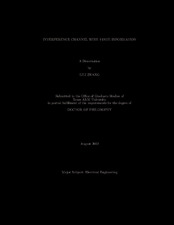| dc.description.abstract | In this dissertation, we study the state-dependent two-user interference channel, where the state information is non-causally known at both transmitters but unknown to either of the receivers. We first propose two coding schemes for the discrete memoryless case: simultaneous encoding for the sub-messages in the first one and super-position encoding in the second one, both with rate splitting and Gel'fand-Pinsker coding. The corresponding achievable rate regions are established. Moreover, for the Gaussian case, we focus on the simultaneous encoding scheme and propose an active interference cancellation mechanism, which is a generalized dirty-paper coding technique, to partially eliminate the state effect at the receivers. The corresponding achievable rate region is then derived. We also propose several heuristic schemes for some special cases: the strong interference case, the mixed interference case, and the weak interference case. For the strong and mixed interference case, numerical results are provided to show that active interference cancellation significantly enlarges the achievable rate region. For the weak interference case, flexible power splitting instead of active interference cancellation improves the performance significantly.
Moreover, we focus on the simplest symmetric case, where both direct link gains are the same with each other, and both interfering link gains are the same with each other. We apply the above coding scheme with different dirty paper coding parameters. When the state is additive and symmetric at both receivers, we study both strong and weak interference scenarios and characterize the theoretical gap between the achievable symmetric rate and the upper bound, which is shown to be less than 1/4 bit for the strong interference case and less than 3/4 bit for the weak interference case. Then we provide numerical evaluations of the achievable rates against the upper bound, which validates the theoretical analysis for both strong and weak interference scenarios. Finally, we define the generalized degrees of freedom for the symmetric Gaussian case, and compare the lower bounds against the upper bounds for both strong and weak interference cases. We also show that our achievable schemes can obtain the exact optimal values of the generalized degrees of freedom, i.e., the lower bounds meet the upper bounds for both strong and weak interference cases. | en |


